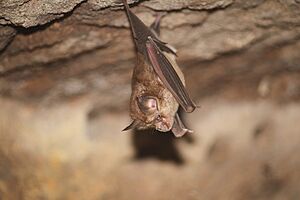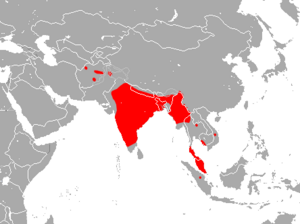Blyth's horseshoe bat facts for kids
Quick facts for kids Blyth's horseshoe bat |
|
|---|---|
 |
|
| Conservation status | |
| Scientific classification | |
| Genus: |
Rhinolophus
|
| Species: |
lepidus
|
 |
|
| Blyth's Horseshoe Bat range | |
The Blyth's horseshoe bat (Rhinolophus lepidus) is a small bat that lives in parts of Asia. It gets its name from the special shape of its nose. This bat is found in many countries, from Afghanistan all the way to Vietnam.
Contents
What is a Horseshoe Bat?
Horseshoe bats are known for their unique nose. It has a special leaf-like shape that helps them with echolocation. This nose leaf looks a bit like a horseshoe. The Blyth's horseshoe bat has a pointed part on its nose leaf called a "sella." This helps scientists tell it apart from other bats.
Meet the Blyth's Horseshoe Bat
This bat is part of the Rhinolophidae family. It was first described in 1844 by a zoologist named Edward Blyth. He likely found the first one near Kolkata, India.
Blyth's horseshoe bats are quite small. Their forearm, which is a good way to measure bats, is about 42 millimeters (or 1.65 inches) long.
How it Finds its Way (Echolocation)
Like many bats, the Blyth's horseshoe bat uses animal echolocation to find its way around. This means it sends out high-pitched sounds. These sounds bounce off objects and come back to the bat. By listening to the echoes, the bat can create a "sound map" of its surroundings.
This special skill helps the bat fly through thick forests. It can find tiny insects to eat, even in the dark. The sounds it makes for echolocation are very high, around 91 kilohertz. Humans cannot hear these sounds.
Where in the World Does it Live?
The Blyth's horseshoe bat lives across a wide area in South and Southeast Asia. You can find it in many countries. These include Afghanistan, Bangladesh, Cambodia, China, India, Indonesia, Malaysia, Myanmar, Nepal, Pakistan, Thailand, and Vietnam.
These bats can live in many different places. They are found from sea level up to very high mountains. Some have been seen as high as 2,338 meters (about 7,670 feet) above sea level.
Day and Night Life
Most bats are active only at night. But on Tioman Island in Malaysia, something interesting happens. The Blyth's horseshoe bats there sometimes fly and hunt during the day! Scientists think this is because there are no birds that hunt bats in that forest. This makes it safe for the bats to look for food even when the sun is out.


